Hybrid Entrepreneurship Interview Report: Challenges and Insights
VerifiedAdded on 2023/06/04
|11
|3044
|202
Report
AI Summary
This report presents an in-depth analysis of an interview with a young Australian hybrid entrepreneur, delving into the contemporary issues of hybrid entrepreneurship. The interviewee, a successful beautician and business owner, shares his experiences, motivations, and the challenges he faces in balancing his employment and business ventures. The report explores the reasons behind choosing a hybrid career path, including financial considerations and the desire to test business ideas while maintaining job security. It also highlights the significant challenges faced by hybrid entrepreneurs, such as balancing time constraints, resource limitations, and work-life integration. The interview provides valuable insights into the realities of hybrid entrepreneurship, offering a comprehensive understanding of its benefits, drawbacks, and its role as a bridge to full-time self-employment. The report concludes with a personal reflection, emphasizing the importance of hybrid entrepreneurship in the current uncertain business environment and its potential for fostering entrepreneurial skills and experiences.
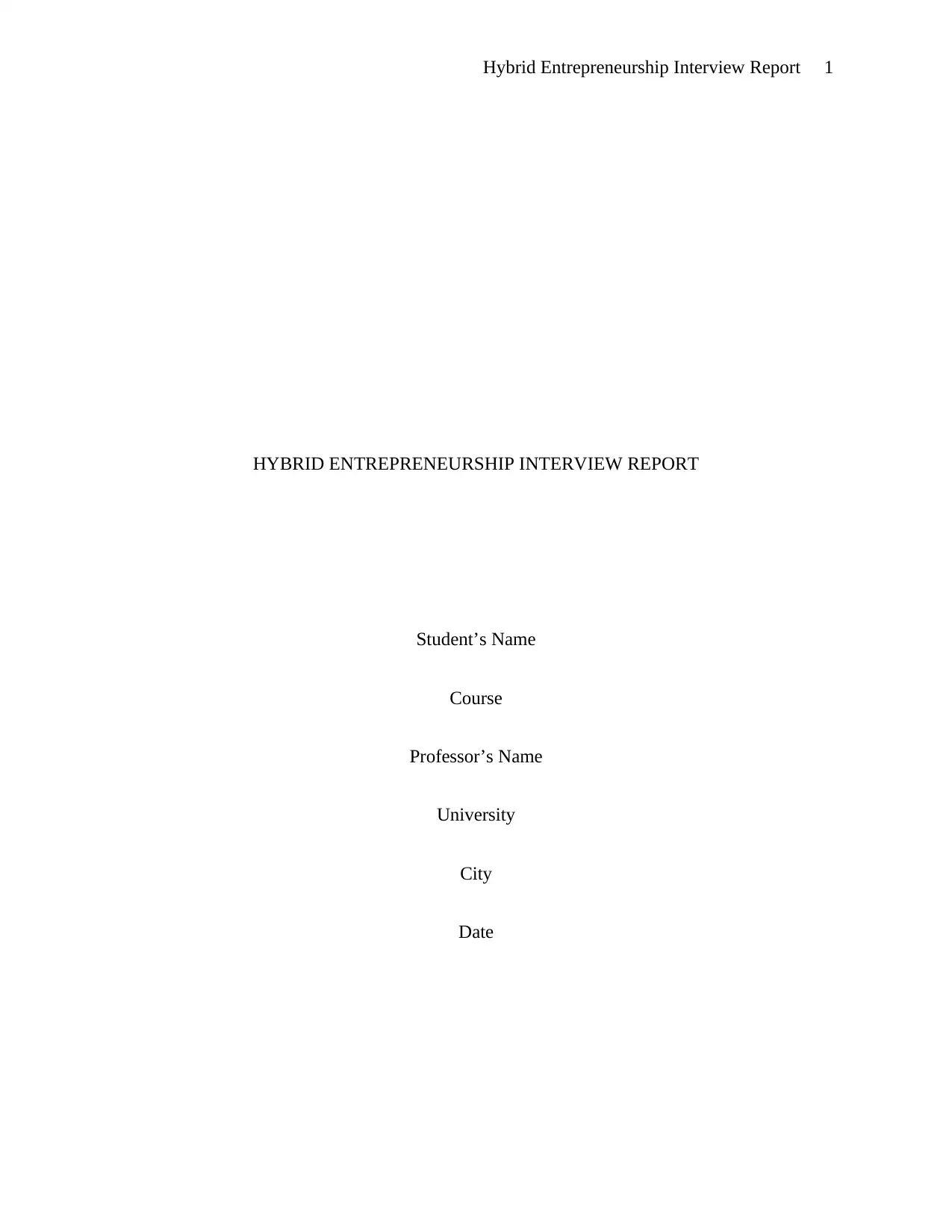
Hybrid Entrepreneurship Interview Report 1
HYBRID ENTREPRENEURSHIP INTERVIEW REPORT
Student’s Name
Course
Professor’s Name
University
City
Date
HYBRID ENTREPRENEURSHIP INTERVIEW REPORT
Student’s Name
Course
Professor’s Name
University
City
Date
Paraphrase This Document
Need a fresh take? Get an instant paraphrase of this document with our AI Paraphraser
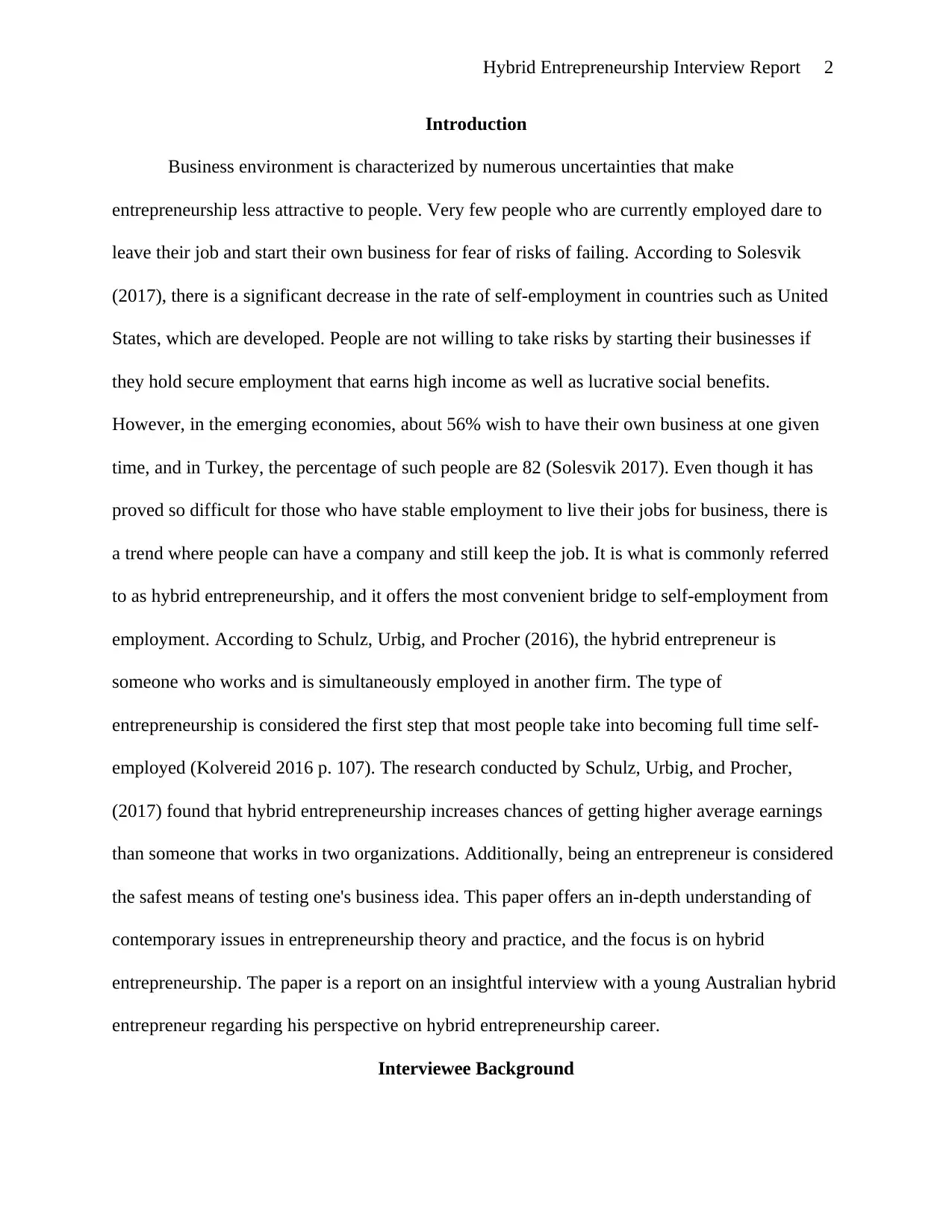
Hybrid Entrepreneurship Interview Report 2
Introduction
Business environment is characterized by numerous uncertainties that make
entrepreneurship less attractive to people. Very few people who are currently employed dare to
leave their job and start their own business for fear of risks of failing. According to Solesvik
(2017), there is a significant decrease in the rate of self-employment in countries such as United
States, which are developed. People are not willing to take risks by starting their businesses if
they hold secure employment that earns high income as well as lucrative social benefits.
However, in the emerging economies, about 56% wish to have their own business at one given
time, and in Turkey, the percentage of such people are 82 (Solesvik 2017). Even though it has
proved so difficult for those who have stable employment to live their jobs for business, there is
a trend where people can have a company and still keep the job. It is what is commonly referred
to as hybrid entrepreneurship, and it offers the most convenient bridge to self-employment from
employment. According to Schulz, Urbig, and Procher (2016), the hybrid entrepreneur is
someone who works and is simultaneously employed in another firm. The type of
entrepreneurship is considered the first step that most people take into becoming full time self-
employed (Kolvereid 2016 p. 107). The research conducted by Schulz, Urbig, and Procher,
(2017) found that hybrid entrepreneurship increases chances of getting higher average earnings
than someone that works in two organizations. Additionally, being an entrepreneur is considered
the safest means of testing one's business idea. This paper offers an in-depth understanding of
contemporary issues in entrepreneurship theory and practice, and the focus is on hybrid
entrepreneurship. The paper is a report on an insightful interview with a young Australian hybrid
entrepreneur regarding his perspective on hybrid entrepreneurship career.
Interviewee Background
Introduction
Business environment is characterized by numerous uncertainties that make
entrepreneurship less attractive to people. Very few people who are currently employed dare to
leave their job and start their own business for fear of risks of failing. According to Solesvik
(2017), there is a significant decrease in the rate of self-employment in countries such as United
States, which are developed. People are not willing to take risks by starting their businesses if
they hold secure employment that earns high income as well as lucrative social benefits.
However, in the emerging economies, about 56% wish to have their own business at one given
time, and in Turkey, the percentage of such people are 82 (Solesvik 2017). Even though it has
proved so difficult for those who have stable employment to live their jobs for business, there is
a trend where people can have a company and still keep the job. It is what is commonly referred
to as hybrid entrepreneurship, and it offers the most convenient bridge to self-employment from
employment. According to Schulz, Urbig, and Procher (2016), the hybrid entrepreneur is
someone who works and is simultaneously employed in another firm. The type of
entrepreneurship is considered the first step that most people take into becoming full time self-
employed (Kolvereid 2016 p. 107). The research conducted by Schulz, Urbig, and Procher,
(2017) found that hybrid entrepreneurship increases chances of getting higher average earnings
than someone that works in two organizations. Additionally, being an entrepreneur is considered
the safest means of testing one's business idea. This paper offers an in-depth understanding of
contemporary issues in entrepreneurship theory and practice, and the focus is on hybrid
entrepreneurship. The paper is a report on an insightful interview with a young Australian hybrid
entrepreneur regarding his perspective on hybrid entrepreneurship career.
Interviewee Background
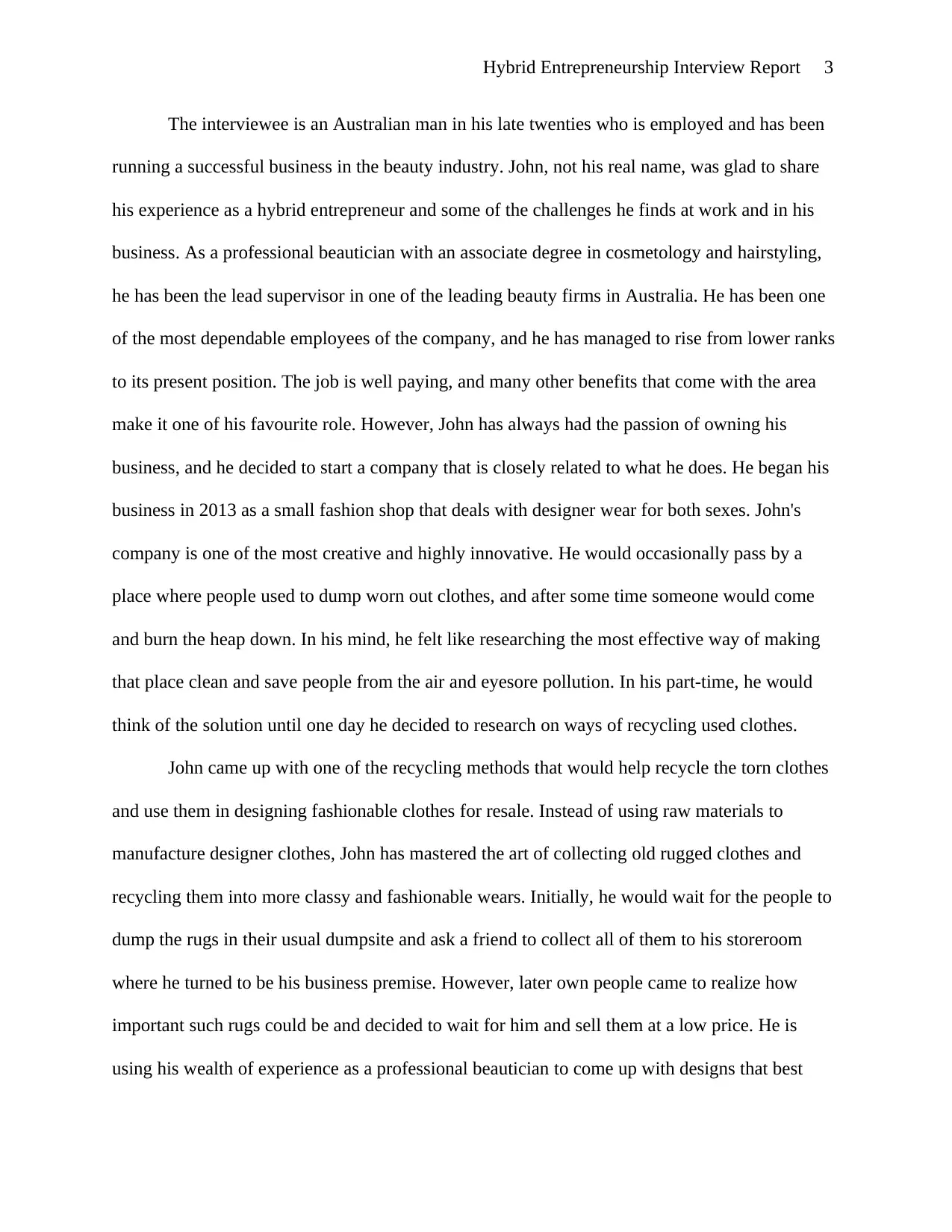
Hybrid Entrepreneurship Interview Report 3
The interviewee is an Australian man in his late twenties who is employed and has been
running a successful business in the beauty industry. John, not his real name, was glad to share
his experience as a hybrid entrepreneur and some of the challenges he finds at work and in his
business. As a professional beautician with an associate degree in cosmetology and hairstyling,
he has been the lead supervisor in one of the leading beauty firms in Australia. He has been one
of the most dependable employees of the company, and he has managed to rise from lower ranks
to its present position. The job is well paying, and many other benefits that come with the area
make it one of his favourite role. However, John has always had the passion of owning his
business, and he decided to start a company that is closely related to what he does. He began his
business in 2013 as a small fashion shop that deals with designer wear for both sexes. John's
company is one of the most creative and highly innovative. He would occasionally pass by a
place where people used to dump worn out clothes, and after some time someone would come
and burn the heap down. In his mind, he felt like researching the most effective way of making
that place clean and save people from the air and eyesore pollution. In his part-time, he would
think of the solution until one day he decided to research on ways of recycling used clothes.
John came up with one of the recycling methods that would help recycle the torn clothes
and use them in designing fashionable clothes for resale. Instead of using raw materials to
manufacture designer clothes, John has mastered the art of collecting old rugged clothes and
recycling them into more classy and fashionable wears. Initially, he would wait for the people to
dump the rugs in their usual dumpsite and ask a friend to collect all of them to his storeroom
where he turned to be his business premise. However, later own people came to realize how
important such rugs could be and decided to wait for him and sell them at a low price. He is
using his wealth of experience as a professional beautician to come up with designs that best
The interviewee is an Australian man in his late twenties who is employed and has been
running a successful business in the beauty industry. John, not his real name, was glad to share
his experience as a hybrid entrepreneur and some of the challenges he finds at work and in his
business. As a professional beautician with an associate degree in cosmetology and hairstyling,
he has been the lead supervisor in one of the leading beauty firms in Australia. He has been one
of the most dependable employees of the company, and he has managed to rise from lower ranks
to its present position. The job is well paying, and many other benefits that come with the area
make it one of his favourite role. However, John has always had the passion of owning his
business, and he decided to start a company that is closely related to what he does. He began his
business in 2013 as a small fashion shop that deals with designer wear for both sexes. John's
company is one of the most creative and highly innovative. He would occasionally pass by a
place where people used to dump worn out clothes, and after some time someone would come
and burn the heap down. In his mind, he felt like researching the most effective way of making
that place clean and save people from the air and eyesore pollution. In his part-time, he would
think of the solution until one day he decided to research on ways of recycling used clothes.
John came up with one of the recycling methods that would help recycle the torn clothes
and use them in designing fashionable clothes for resale. Instead of using raw materials to
manufacture designer clothes, John has mastered the art of collecting old rugged clothes and
recycling them into more classy and fashionable wears. Initially, he would wait for the people to
dump the rugs in their usual dumpsite and ask a friend to collect all of them to his storeroom
where he turned to be his business premise. However, later own people came to realize how
important such rugs could be and decided to wait for him and sell them at a low price. He is
using his wealth of experience as a professional beautician to come up with designs that best
⊘ This is a preview!⊘
Do you want full access?
Subscribe today to unlock all pages.

Trusted by 1+ million students worldwide
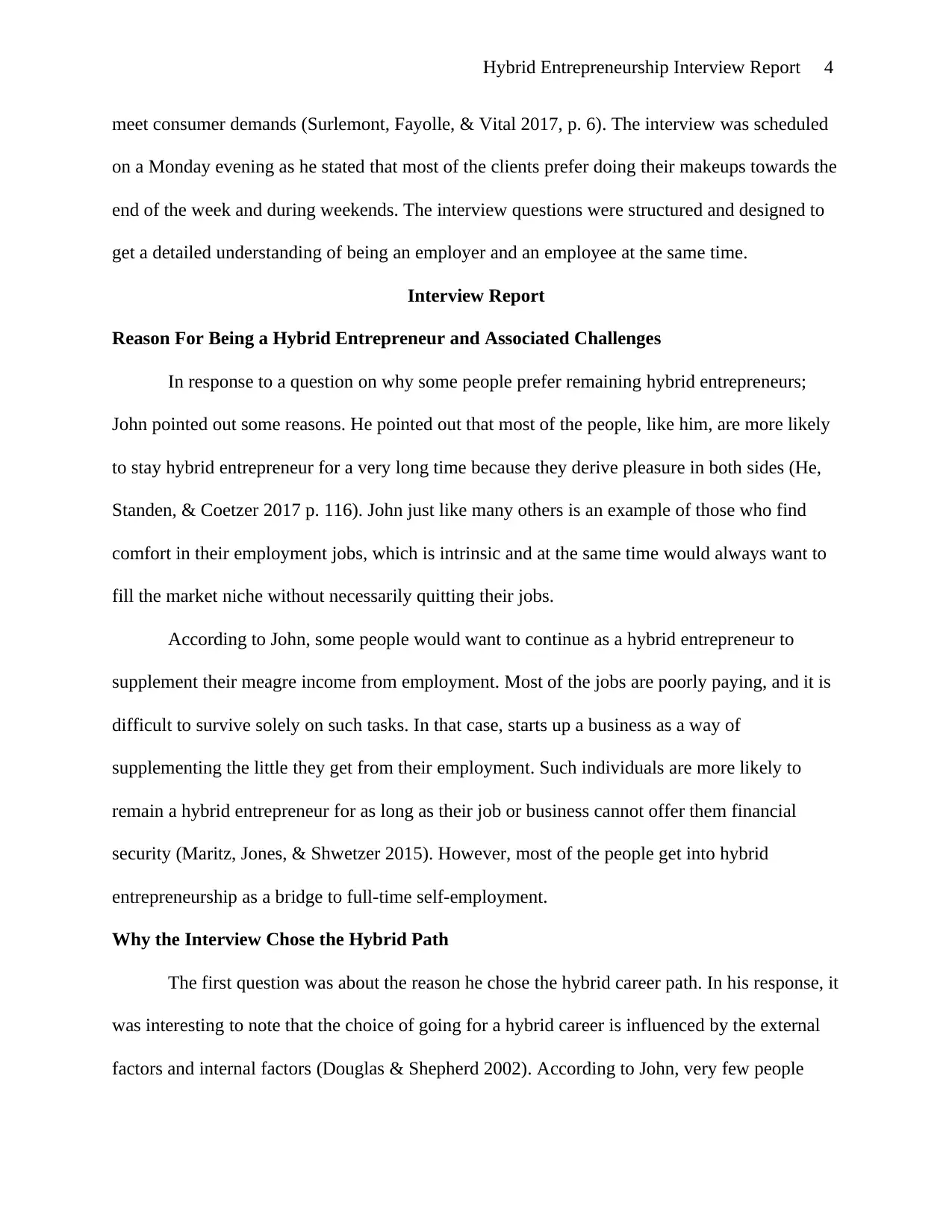
Hybrid Entrepreneurship Interview Report 4
meet consumer demands (Surlemont, Fayolle, & Vital 2017, p. 6). The interview was scheduled
on a Monday evening as he stated that most of the clients prefer doing their makeups towards the
end of the week and during weekends. The interview questions were structured and designed to
get a detailed understanding of being an employer and an employee at the same time.
Interview Report
Reason For Being a Hybrid Entrepreneur and Associated Challenges
In response to a question on why some people prefer remaining hybrid entrepreneurs;
John pointed out some reasons. He pointed out that most of the people, like him, are more likely
to stay hybrid entrepreneur for a very long time because they derive pleasure in both sides (He,
Standen, & Coetzer 2017 p. 116). John just like many others is an example of those who find
comfort in their employment jobs, which is intrinsic and at the same time would always want to
fill the market niche without necessarily quitting their jobs.
According to John, some people would want to continue as a hybrid entrepreneur to
supplement their meagre income from employment. Most of the jobs are poorly paying, and it is
difficult to survive solely on such tasks. In that case, starts up a business as a way of
supplementing the little they get from their employment. Such individuals are more likely to
remain a hybrid entrepreneur for as long as their job or business cannot offer them financial
security (Maritz, Jones, & Shwetzer 2015). However, most of the people get into hybrid
entrepreneurship as a bridge to full-time self-employment.
Why the Interview Chose the Hybrid Path
The first question was about the reason he chose the hybrid career path. In his response, it
was interesting to note that the choice of going for a hybrid career is influenced by the external
factors and internal factors (Douglas & Shepherd 2002). According to John, very few people
meet consumer demands (Surlemont, Fayolle, & Vital 2017, p. 6). The interview was scheduled
on a Monday evening as he stated that most of the clients prefer doing their makeups towards the
end of the week and during weekends. The interview questions were structured and designed to
get a detailed understanding of being an employer and an employee at the same time.
Interview Report
Reason For Being a Hybrid Entrepreneur and Associated Challenges
In response to a question on why some people prefer remaining hybrid entrepreneurs;
John pointed out some reasons. He pointed out that most of the people, like him, are more likely
to stay hybrid entrepreneur for a very long time because they derive pleasure in both sides (He,
Standen, & Coetzer 2017 p. 116). John just like many others is an example of those who find
comfort in their employment jobs, which is intrinsic and at the same time would always want to
fill the market niche without necessarily quitting their jobs.
According to John, some people would want to continue as a hybrid entrepreneur to
supplement their meagre income from employment. Most of the jobs are poorly paying, and it is
difficult to survive solely on such tasks. In that case, starts up a business as a way of
supplementing the little they get from their employment. Such individuals are more likely to
remain a hybrid entrepreneur for as long as their job or business cannot offer them financial
security (Maritz, Jones, & Shwetzer 2015). However, most of the people get into hybrid
entrepreneurship as a bridge to full-time self-employment.
Why the Interview Chose the Hybrid Path
The first question was about the reason he chose the hybrid career path. In his response, it
was interesting to note that the choice of going for a hybrid career is influenced by the external
factors and internal factors (Douglas & Shepherd 2002). According to John, very few people
Paraphrase This Document
Need a fresh take? Get an instant paraphrase of this document with our AI Paraphraser
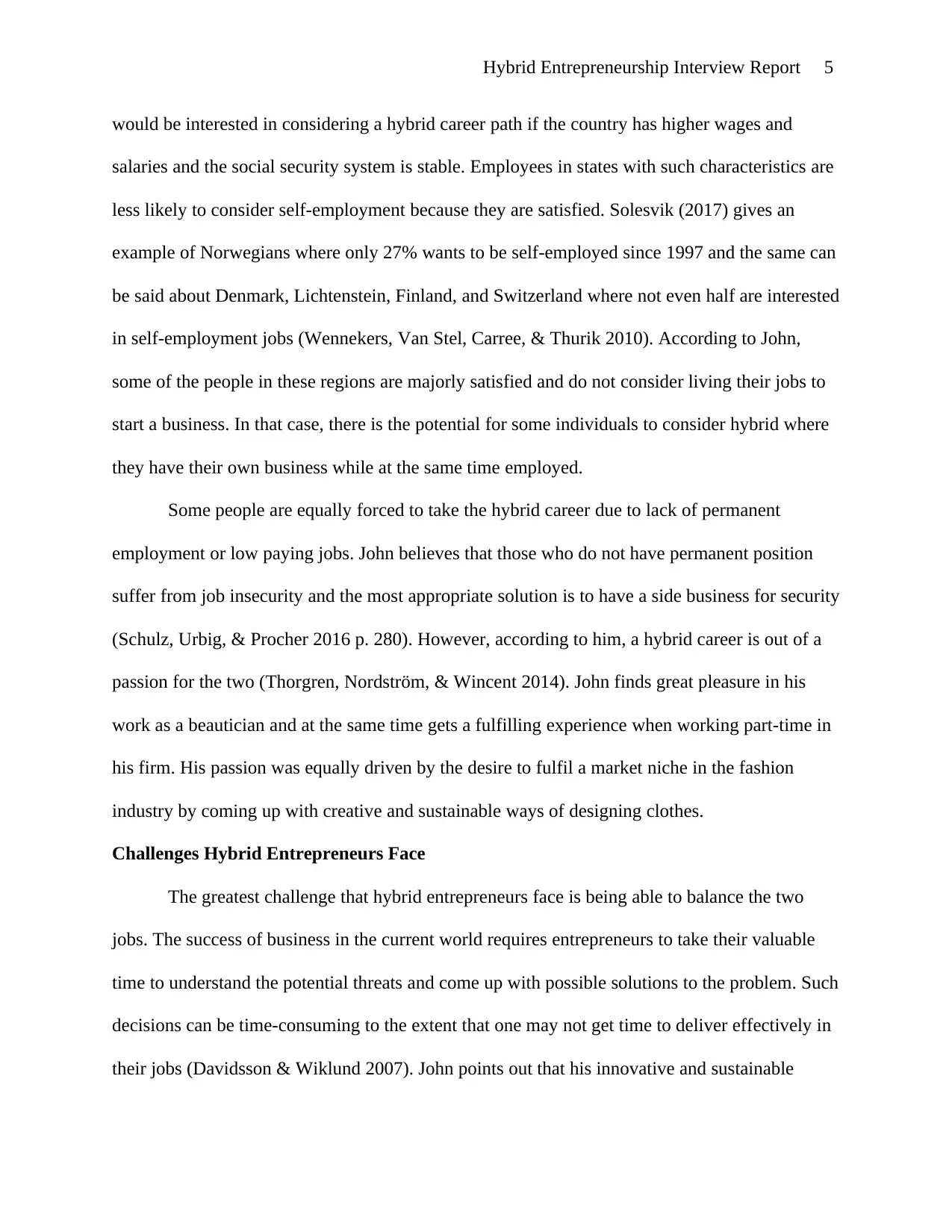
Hybrid Entrepreneurship Interview Report 5
would be interested in considering a hybrid career path if the country has higher wages and
salaries and the social security system is stable. Employees in states with such characteristics are
less likely to consider self-employment because they are satisfied. Solesvik (2017) gives an
example of Norwegians where only 27% wants to be self-employed since 1997 and the same can
be said about Denmark, Lichtenstein, Finland, and Switzerland where not even half are interested
in self-employment jobs (Wennekers, Van Stel, Carree, & Thurik 2010). According to John,
some of the people in these regions are majorly satisfied and do not consider living their jobs to
start a business. In that case, there is the potential for some individuals to consider hybrid where
they have their own business while at the same time employed.
Some people are equally forced to take the hybrid career due to lack of permanent
employment or low paying jobs. John believes that those who do not have permanent position
suffer from job insecurity and the most appropriate solution is to have a side business for security
(Schulz, Urbig, & Procher 2016 p. 280). However, according to him, a hybrid career is out of a
passion for the two (Thorgren, Nordström, & Wincent 2014). John finds great pleasure in his
work as a beautician and at the same time gets a fulfilling experience when working part-time in
his firm. His passion was equally driven by the desire to fulfil a market niche in the fashion
industry by coming up with creative and sustainable ways of designing clothes.
Challenges Hybrid Entrepreneurs Face
The greatest challenge that hybrid entrepreneurs face is being able to balance the two
jobs. The success of business in the current world requires entrepreneurs to take their valuable
time to understand the potential threats and come up with possible solutions to the problem. Such
decisions can be time-consuming to the extent that one may not get time to deliver effectively in
their jobs (Davidsson & Wiklund 2007). John points out that his innovative and sustainable
would be interested in considering a hybrid career path if the country has higher wages and
salaries and the social security system is stable. Employees in states with such characteristics are
less likely to consider self-employment because they are satisfied. Solesvik (2017) gives an
example of Norwegians where only 27% wants to be self-employed since 1997 and the same can
be said about Denmark, Lichtenstein, Finland, and Switzerland where not even half are interested
in self-employment jobs (Wennekers, Van Stel, Carree, & Thurik 2010). According to John,
some of the people in these regions are majorly satisfied and do not consider living their jobs to
start a business. In that case, there is the potential for some individuals to consider hybrid where
they have their own business while at the same time employed.
Some people are equally forced to take the hybrid career due to lack of permanent
employment or low paying jobs. John believes that those who do not have permanent position
suffer from job insecurity and the most appropriate solution is to have a side business for security
(Schulz, Urbig, & Procher 2016 p. 280). However, according to him, a hybrid career is out of a
passion for the two (Thorgren, Nordström, & Wincent 2014). John finds great pleasure in his
work as a beautician and at the same time gets a fulfilling experience when working part-time in
his firm. His passion was equally driven by the desire to fulfil a market niche in the fashion
industry by coming up with creative and sustainable ways of designing clothes.
Challenges Hybrid Entrepreneurs Face
The greatest challenge that hybrid entrepreneurs face is being able to balance the two
jobs. The success of business in the current world requires entrepreneurs to take their valuable
time to understand the potential threats and come up with possible solutions to the problem. Such
decisions can be time-consuming to the extent that one may not get time to deliver effectively in
their jobs (Davidsson & Wiklund 2007). John points out that his innovative and sustainable
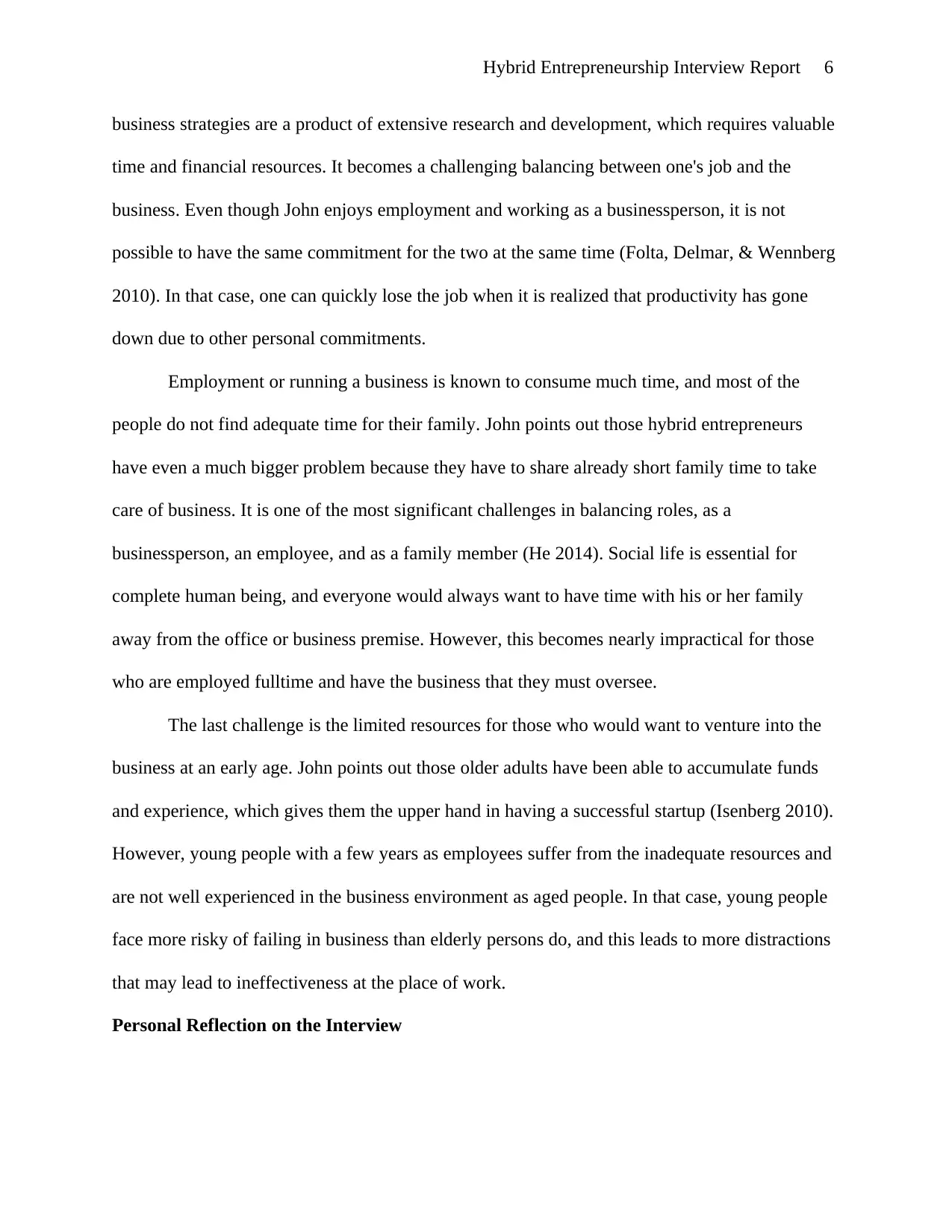
Hybrid Entrepreneurship Interview Report 6
business strategies are a product of extensive research and development, which requires valuable
time and financial resources. It becomes a challenging balancing between one's job and the
business. Even though John enjoys employment and working as a businessperson, it is not
possible to have the same commitment for the two at the same time (Folta, Delmar, & Wennberg
2010). In that case, one can quickly lose the job when it is realized that productivity has gone
down due to other personal commitments.
Employment or running a business is known to consume much time, and most of the
people do not find adequate time for their family. John points out those hybrid entrepreneurs
have even a much bigger problem because they have to share already short family time to take
care of business. It is one of the most significant challenges in balancing roles, as a
businessperson, an employee, and as a family member (He 2014). Social life is essential for
complete human being, and everyone would always want to have time with his or her family
away from the office or business premise. However, this becomes nearly impractical for those
who are employed fulltime and have the business that they must oversee.
The last challenge is the limited resources for those who would want to venture into the
business at an early age. John points out those older adults have been able to accumulate funds
and experience, which gives them the upper hand in having a successful startup (Isenberg 2010).
However, young people with a few years as employees suffer from the inadequate resources and
are not well experienced in the business environment as aged people. In that case, young people
face more risky of failing in business than elderly persons do, and this leads to more distractions
that may lead to ineffectiveness at the place of work.
Personal Reflection on the Interview
business strategies are a product of extensive research and development, which requires valuable
time and financial resources. It becomes a challenging balancing between one's job and the
business. Even though John enjoys employment and working as a businessperson, it is not
possible to have the same commitment for the two at the same time (Folta, Delmar, & Wennberg
2010). In that case, one can quickly lose the job when it is realized that productivity has gone
down due to other personal commitments.
Employment or running a business is known to consume much time, and most of the
people do not find adequate time for their family. John points out those hybrid entrepreneurs
have even a much bigger problem because they have to share already short family time to take
care of business. It is one of the most significant challenges in balancing roles, as a
businessperson, an employee, and as a family member (He 2014). Social life is essential for
complete human being, and everyone would always want to have time with his or her family
away from the office or business premise. However, this becomes nearly impractical for those
who are employed fulltime and have the business that they must oversee.
The last challenge is the limited resources for those who would want to venture into the
business at an early age. John points out those older adults have been able to accumulate funds
and experience, which gives them the upper hand in having a successful startup (Isenberg 2010).
However, young people with a few years as employees suffer from the inadequate resources and
are not well experienced in the business environment as aged people. In that case, young people
face more risky of failing in business than elderly persons do, and this leads to more distractions
that may lead to ineffectiveness at the place of work.
Personal Reflection on the Interview
⊘ This is a preview!⊘
Do you want full access?
Subscribe today to unlock all pages.

Trusted by 1+ million students worldwide
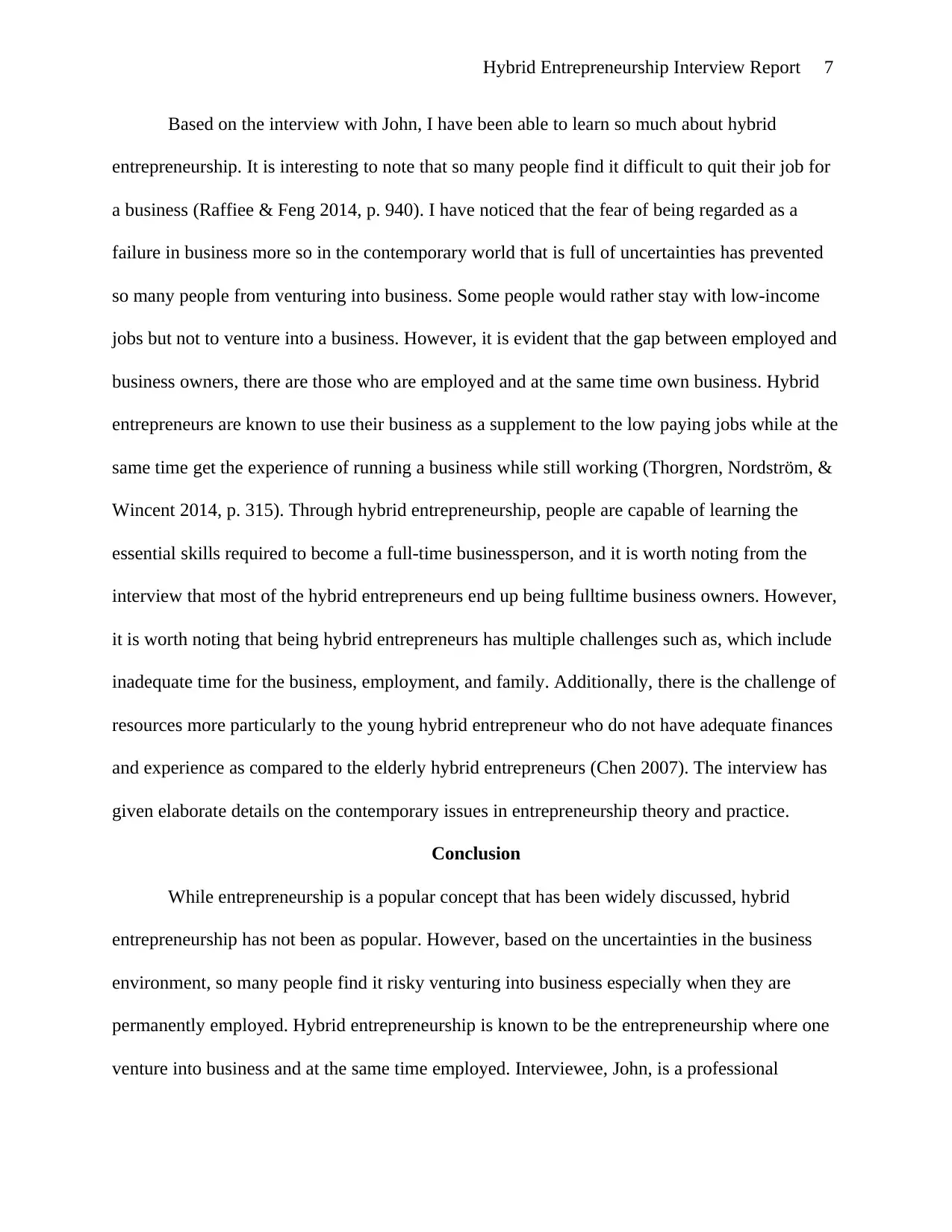
Hybrid Entrepreneurship Interview Report 7
Based on the interview with John, I have been able to learn so much about hybrid
entrepreneurship. It is interesting to note that so many people find it difficult to quit their job for
a business (Raffiee & Feng 2014, p. 940). I have noticed that the fear of being regarded as a
failure in business more so in the contemporary world that is full of uncertainties has prevented
so many people from venturing into business. Some people would rather stay with low-income
jobs but not to venture into a business. However, it is evident that the gap between employed and
business owners, there are those who are employed and at the same time own business. Hybrid
entrepreneurs are known to use their business as a supplement to the low paying jobs while at the
same time get the experience of running a business while still working (Thorgren, Nordström, &
Wincent 2014, p. 315). Through hybrid entrepreneurship, people are capable of learning the
essential skills required to become a full-time businessperson, and it is worth noting from the
interview that most of the hybrid entrepreneurs end up being fulltime business owners. However,
it is worth noting that being hybrid entrepreneurs has multiple challenges such as, which include
inadequate time for the business, employment, and family. Additionally, there is the challenge of
resources more particularly to the young hybrid entrepreneur who do not have adequate finances
and experience as compared to the elderly hybrid entrepreneurs (Chen 2007). The interview has
given elaborate details on the contemporary issues in entrepreneurship theory and practice.
Conclusion
While entrepreneurship is a popular concept that has been widely discussed, hybrid
entrepreneurship has not been as popular. However, based on the uncertainties in the business
environment, so many people find it risky venturing into business especially when they are
permanently employed. Hybrid entrepreneurship is known to be the entrepreneurship where one
venture into business and at the same time employed. Interviewee, John, is a professional
Based on the interview with John, I have been able to learn so much about hybrid
entrepreneurship. It is interesting to note that so many people find it difficult to quit their job for
a business (Raffiee & Feng 2014, p. 940). I have noticed that the fear of being regarded as a
failure in business more so in the contemporary world that is full of uncertainties has prevented
so many people from venturing into business. Some people would rather stay with low-income
jobs but not to venture into a business. However, it is evident that the gap between employed and
business owners, there are those who are employed and at the same time own business. Hybrid
entrepreneurs are known to use their business as a supplement to the low paying jobs while at the
same time get the experience of running a business while still working (Thorgren, Nordström, &
Wincent 2014, p. 315). Through hybrid entrepreneurship, people are capable of learning the
essential skills required to become a full-time businessperson, and it is worth noting from the
interview that most of the hybrid entrepreneurs end up being fulltime business owners. However,
it is worth noting that being hybrid entrepreneurs has multiple challenges such as, which include
inadequate time for the business, employment, and family. Additionally, there is the challenge of
resources more particularly to the young hybrid entrepreneur who do not have adequate finances
and experience as compared to the elderly hybrid entrepreneurs (Chen 2007). The interview has
given elaborate details on the contemporary issues in entrepreneurship theory and practice.
Conclusion
While entrepreneurship is a popular concept that has been widely discussed, hybrid
entrepreneurship has not been as popular. However, based on the uncertainties in the business
environment, so many people find it risky venturing into business especially when they are
permanently employed. Hybrid entrepreneurship is known to be the entrepreneurship where one
venture into business and at the same time employed. Interviewee, John, is a professional
Paraphrase This Document
Need a fresh take? Get an instant paraphrase of this document with our AI Paraphraser
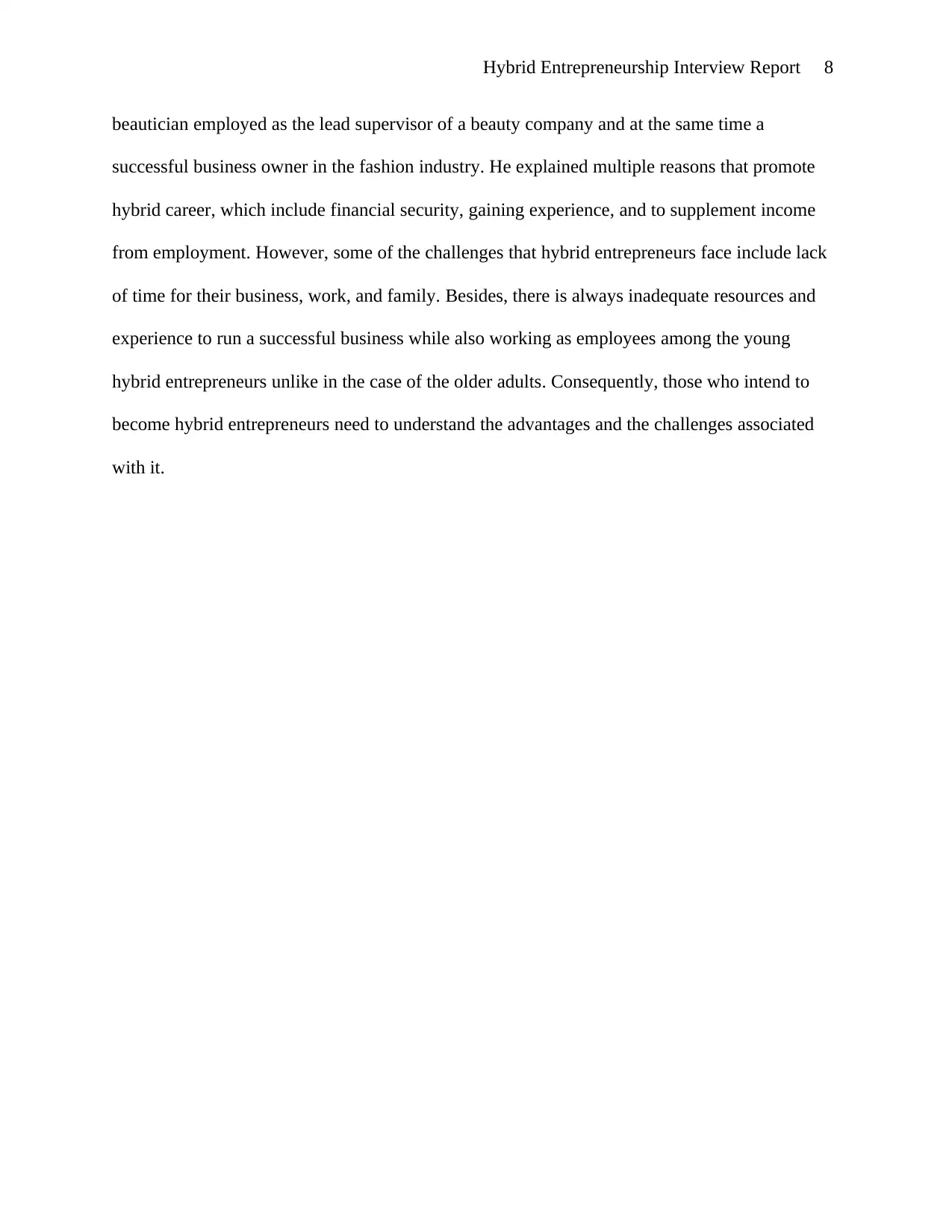
Hybrid Entrepreneurship Interview Report 8
beautician employed as the lead supervisor of a beauty company and at the same time a
successful business owner in the fashion industry. He explained multiple reasons that promote
hybrid career, which include financial security, gaining experience, and to supplement income
from employment. However, some of the challenges that hybrid entrepreneurs face include lack
of time for their business, work, and family. Besides, there is always inadequate resources and
experience to run a successful business while also working as employees among the young
hybrid entrepreneurs unlike in the case of the older adults. Consequently, those who intend to
become hybrid entrepreneurs need to understand the advantages and the challenges associated
with it.
beautician employed as the lead supervisor of a beauty company and at the same time a
successful business owner in the fashion industry. He explained multiple reasons that promote
hybrid career, which include financial security, gaining experience, and to supplement income
from employment. However, some of the challenges that hybrid entrepreneurs face include lack
of time for their business, work, and family. Besides, there is always inadequate resources and
experience to run a successful business while also working as employees among the young
hybrid entrepreneurs unlike in the case of the older adults. Consequently, those who intend to
become hybrid entrepreneurs need to understand the advantages and the challenges associated
with it.
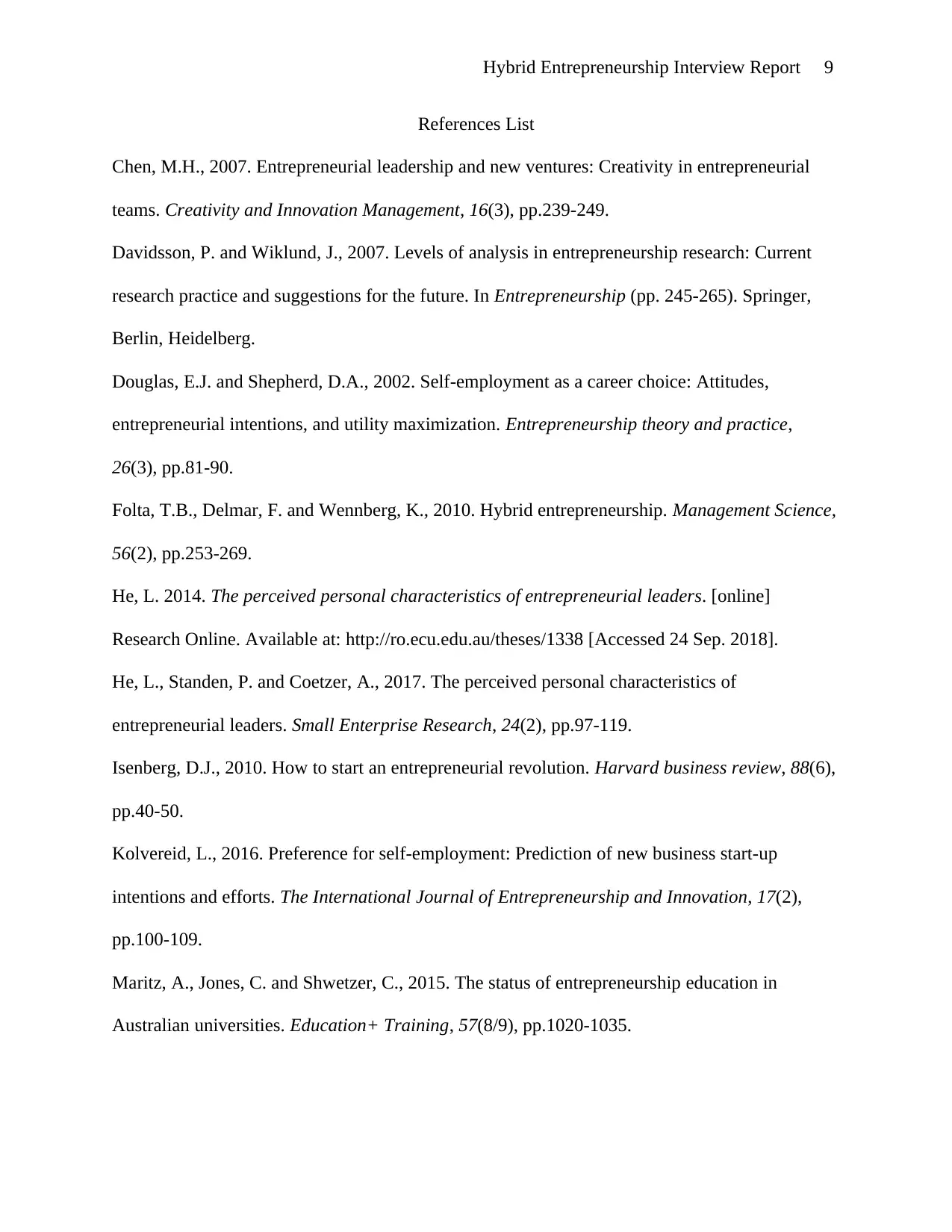
Hybrid Entrepreneurship Interview Report 9
References List
Chen, M.H., 2007. Entrepreneurial leadership and new ventures: Creativity in entrepreneurial
teams. Creativity and Innovation Management, 16(3), pp.239-249.
Davidsson, P. and Wiklund, J., 2007. Levels of analysis in entrepreneurship research: Current
research practice and suggestions for the future. In Entrepreneurship (pp. 245-265). Springer,
Berlin, Heidelberg.
Douglas, E.J. and Shepherd, D.A., 2002. Self-employment as a career choice: Attitudes,
entrepreneurial intentions, and utility maximization. Entrepreneurship theory and practice,
26(3), pp.81-90.
Folta, T.B., Delmar, F. and Wennberg, K., 2010. Hybrid entrepreneurship. Management Science,
56(2), pp.253-269.
He, L. 2014. The perceived personal characteristics of entrepreneurial leaders. [online]
Research Online. Available at: http://ro.ecu.edu.au/theses/1338 [Accessed 24 Sep. 2018].
He, L., Standen, P. and Coetzer, A., 2017. The perceived personal characteristics of
entrepreneurial leaders. Small Enterprise Research, 24(2), pp.97-119.
Isenberg, D.J., 2010. How to start an entrepreneurial revolution. Harvard business review, 88(6),
pp.40-50.
Kolvereid, L., 2016. Preference for self-employment: Prediction of new business start-up
intentions and efforts. The International Journal of Entrepreneurship and Innovation, 17(2),
pp.100-109.
Maritz, A., Jones, C. and Shwetzer, C., 2015. The status of entrepreneurship education in
Australian universities. Education+ Training, 57(8/9), pp.1020-1035.
References List
Chen, M.H., 2007. Entrepreneurial leadership and new ventures: Creativity in entrepreneurial
teams. Creativity and Innovation Management, 16(3), pp.239-249.
Davidsson, P. and Wiklund, J., 2007. Levels of analysis in entrepreneurship research: Current
research practice and suggestions for the future. In Entrepreneurship (pp. 245-265). Springer,
Berlin, Heidelberg.
Douglas, E.J. and Shepherd, D.A., 2002. Self-employment as a career choice: Attitudes,
entrepreneurial intentions, and utility maximization. Entrepreneurship theory and practice,
26(3), pp.81-90.
Folta, T.B., Delmar, F. and Wennberg, K., 2010. Hybrid entrepreneurship. Management Science,
56(2), pp.253-269.
He, L. 2014. The perceived personal characteristics of entrepreneurial leaders. [online]
Research Online. Available at: http://ro.ecu.edu.au/theses/1338 [Accessed 24 Sep. 2018].
He, L., Standen, P. and Coetzer, A., 2017. The perceived personal characteristics of
entrepreneurial leaders. Small Enterprise Research, 24(2), pp.97-119.
Isenberg, D.J., 2010. How to start an entrepreneurial revolution. Harvard business review, 88(6),
pp.40-50.
Kolvereid, L., 2016. Preference for self-employment: Prediction of new business start-up
intentions and efforts. The International Journal of Entrepreneurship and Innovation, 17(2),
pp.100-109.
Maritz, A., Jones, C. and Shwetzer, C., 2015. The status of entrepreneurship education in
Australian universities. Education+ Training, 57(8/9), pp.1020-1035.
⊘ This is a preview!⊘
Do you want full access?
Subscribe today to unlock all pages.

Trusted by 1+ million students worldwide
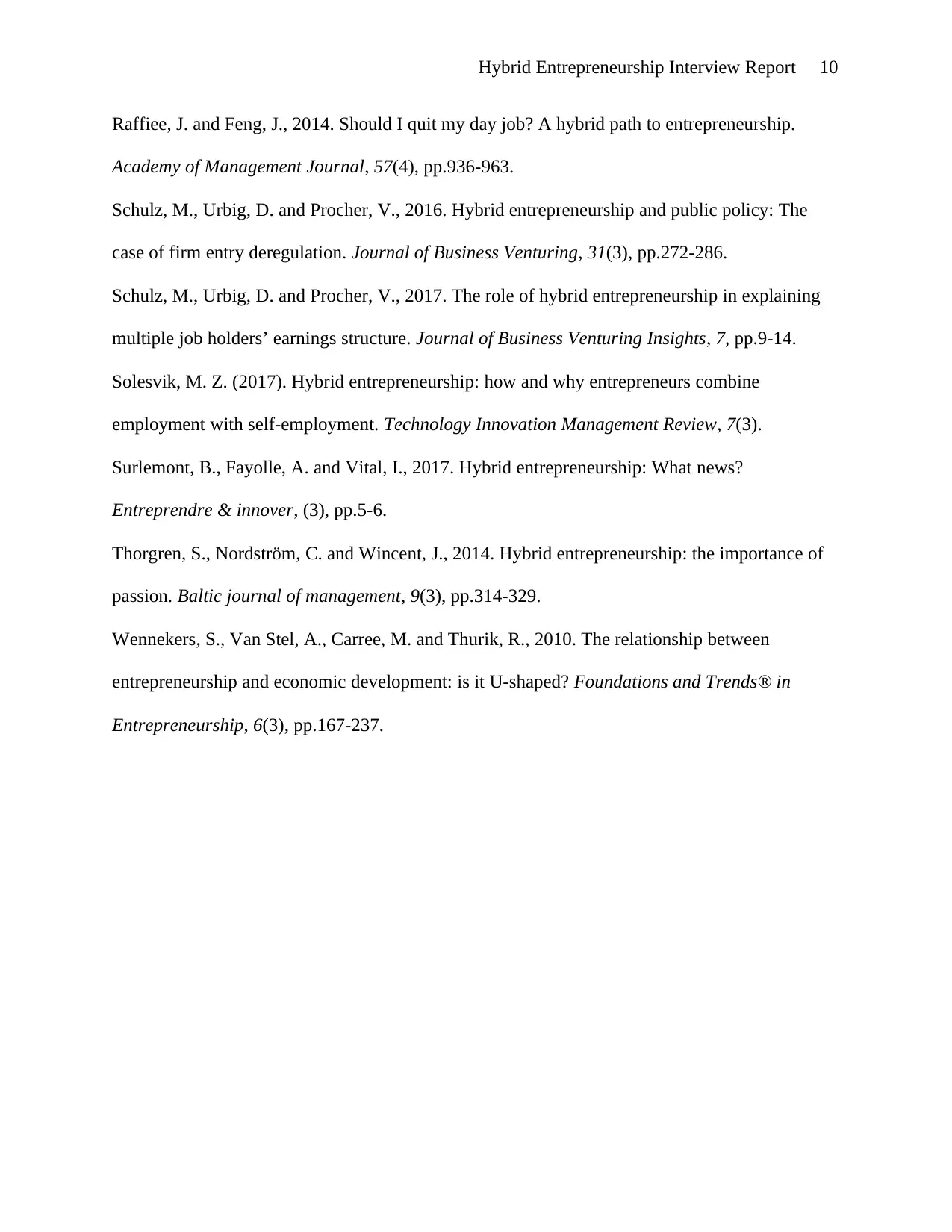
Hybrid Entrepreneurship Interview Report 10
Raffiee, J. and Feng, J., 2014. Should I quit my day job? A hybrid path to entrepreneurship.
Academy of Management Journal, 57(4), pp.936-963.
Schulz, M., Urbig, D. and Procher, V., 2016. Hybrid entrepreneurship and public policy: The
case of firm entry deregulation. Journal of Business Venturing, 31(3), pp.272-286.
Schulz, M., Urbig, D. and Procher, V., 2017. The role of hybrid entrepreneurship in explaining
multiple job holders’ earnings structure. Journal of Business Venturing Insights, 7, pp.9-14.
Solesvik, M. Z. (2017). Hybrid entrepreneurship: how and why entrepreneurs combine
employment with self-employment. Technology Innovation Management Review, 7(3).
Surlemont, B., Fayolle, A. and Vital, I., 2017. Hybrid entrepreneurship: What news?
Entreprendre & innover, (3), pp.5-6.
Thorgren, S., Nordström, C. and Wincent, J., 2014. Hybrid entrepreneurship: the importance of
passion. Baltic journal of management, 9(3), pp.314-329.
Wennekers, S., Van Stel, A., Carree, M. and Thurik, R., 2010. The relationship between
entrepreneurship and economic development: is it U-shaped? Foundations and Trends® in
Entrepreneurship, 6(3), pp.167-237.
Raffiee, J. and Feng, J., 2014. Should I quit my day job? A hybrid path to entrepreneurship.
Academy of Management Journal, 57(4), pp.936-963.
Schulz, M., Urbig, D. and Procher, V., 2016. Hybrid entrepreneurship and public policy: The
case of firm entry deregulation. Journal of Business Venturing, 31(3), pp.272-286.
Schulz, M., Urbig, D. and Procher, V., 2017. The role of hybrid entrepreneurship in explaining
multiple job holders’ earnings structure. Journal of Business Venturing Insights, 7, pp.9-14.
Solesvik, M. Z. (2017). Hybrid entrepreneurship: how and why entrepreneurs combine
employment with self-employment. Technology Innovation Management Review, 7(3).
Surlemont, B., Fayolle, A. and Vital, I., 2017. Hybrid entrepreneurship: What news?
Entreprendre & innover, (3), pp.5-6.
Thorgren, S., Nordström, C. and Wincent, J., 2014. Hybrid entrepreneurship: the importance of
passion. Baltic journal of management, 9(3), pp.314-329.
Wennekers, S., Van Stel, A., Carree, M. and Thurik, R., 2010. The relationship between
entrepreneurship and economic development: is it U-shaped? Foundations and Trends® in
Entrepreneurship, 6(3), pp.167-237.
Paraphrase This Document
Need a fresh take? Get an instant paraphrase of this document with our AI Paraphraser
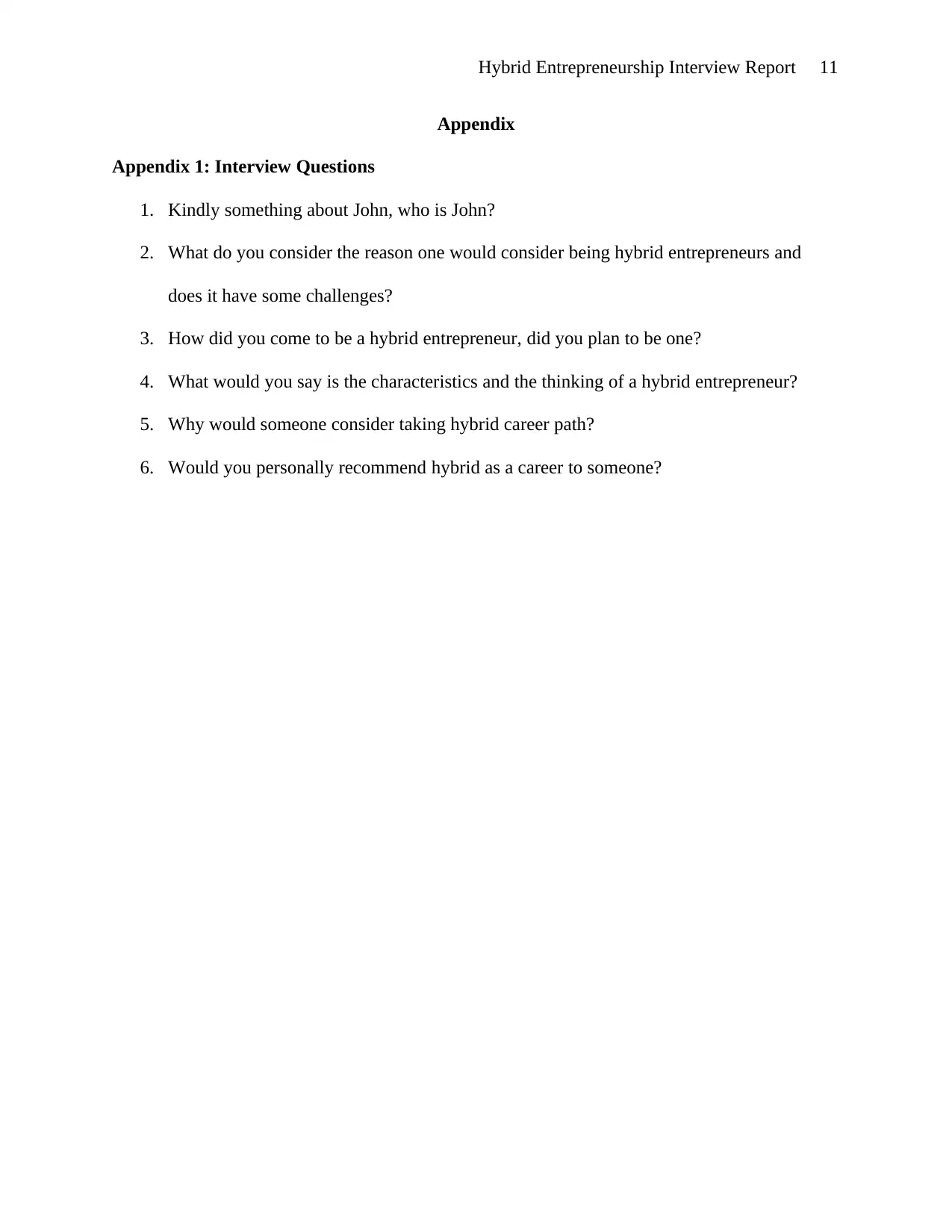
Hybrid Entrepreneurship Interview Report 11
Appendix
Appendix 1: Interview Questions
1. Kindly something about John, who is John?
2. What do you consider the reason one would consider being hybrid entrepreneurs and
does it have some challenges?
3. How did you come to be a hybrid entrepreneur, did you plan to be one?
4. What would you say is the characteristics and the thinking of a hybrid entrepreneur?
5. Why would someone consider taking hybrid career path?
6. Would you personally recommend hybrid as a career to someone?
Appendix
Appendix 1: Interview Questions
1. Kindly something about John, who is John?
2. What do you consider the reason one would consider being hybrid entrepreneurs and
does it have some challenges?
3. How did you come to be a hybrid entrepreneur, did you plan to be one?
4. What would you say is the characteristics and the thinking of a hybrid entrepreneur?
5. Why would someone consider taking hybrid career path?
6. Would you personally recommend hybrid as a career to someone?
1 out of 11
Related Documents
Your All-in-One AI-Powered Toolkit for Academic Success.
+13062052269
info@desklib.com
Available 24*7 on WhatsApp / Email
![[object Object]](/_next/static/media/star-bottom.7253800d.svg)
Unlock your academic potential
Copyright © 2020–2025 A2Z Services. All Rights Reserved. Developed and managed by ZUCOL.



